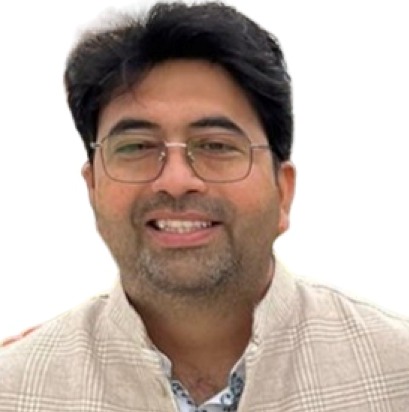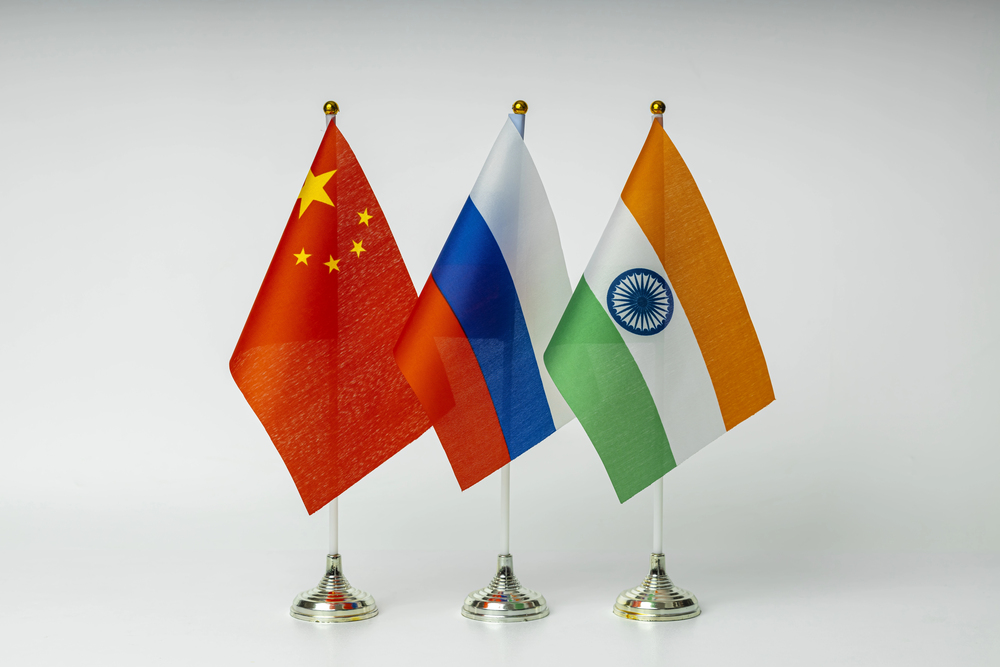Russia has been making statements about revival of the Russia–India–China trilateral mechanism recently. Moscow’s reluctance to end the war with Ukraine could further weaken Russia and fundamentally change the internal equations in the RIC in which Russia could be the weakest link and China the strongest. Picture source: Depositphotos.
Prospects & Perspectives No. 43
Operation Sindoor, RIC & the Balance of Power in Eurasia
By Raj Kumar Sharma
The brief military confrontation between India and Pakistan in early May 2025 has drawn scholarly attention from many perspectives; however, it has not been studied from the Eurasian balance of power standpoint. The Eurasian balance of power had been visibly changing in favor of China even before Russia launched its full scale war against Ukraine in February 2022. Some of the trend lines showing this changing Eurasian balance of power were visible during the India-Pakistan military conflict, which needs to be addressed by India in an appropriate manner.
Pax Sinica & the Eurasian Quad
Russia’s preoccupation with Ukraine and weakening of its economy due to Western sanctions has allowed other powers like Turkey, Azerbaijan and China to consolidate their position in Eurasia. To Moscow’s detriment, Turkey, a NATO member, has been an active security actor in the South Caucasus where it supported Azerbaijan against Armenia during the Nagorno-Karabakh military conflict. Turkey and Azerbaijan had signed a strategic partnership and mutual support agreement in 2010 and military support from Ankara helped Azerbaijan to make territorial gains in 2020 against Armenia. Azerbaijan also supports an “Organization of Turkic States” to promote cooperation between Turkic speaking countries.
These developments are indicative of Azerbaijan’s weakening cultural and security ties with Russia. On the other hand, Armenia, a member of Russia-led Collective Security Treaty Organization (CSTO) has been thinking of moving away from Moscow as is evident from its plans to join the European Union and exit the CSTO. India has been diplomatically and militarily supporting Armenia while Pakistan and Turkey have stood firmly behind Azerbaijan.
Pakistan, Turkey and Azerbaijan (also called Three Brother Alliance), share historical and cultural ties and started conducting joint military exercises, “Three Brothers – 2021” since 2021. They later established a trilateral summit initiative in 2024 while they continuously oppose India’s position on the Kashmir issue at various forums. Turkey’s C-130 military aircraft and one of its naval warships had visited Pakistan after the Pahalgam terror attack while Turkish drones were used by Pakistan to target civilian and military installations along India’s western border during Operation Sindoor.
The biggest challenge to Russia in Eurasia comes from China as “Pax Sinica” is gradually replacing “Pax Russica” in the region. This is being facilitated by Beijing’s Belt and Road Initiative (BRI). Both Turkey and Azerbaijan seek to align with the BRI to alleviate their positions in the regional transportation networks, especially through the middle corridor that connects China to Europe via Central Asia and the Caucasus bypassing Russia. Both Turkey and Azerbaijan have a strategic partnership with China and want to join the Shanghai Cooperation Organization.
Azerbaijan has signed a US$4.6 billion deal recently to buy more JF-17 fighter jets which are jointly produced by China and Pakistan. China, Turkey and Azerbaijan supported Pakistan during its recent military tensions with India leading to emergence of a “Eurasian Quad” which has a strategic orientation against India.
RIC & Operation Sindoor
The developments during and after Operation Sindoor not only exhibited a weak Russian hand but also showed that the trilateral mechanism, RIC (Russia, India, China) has a Pakistan problem to deal with. India has found it difficult to rely on Russia in its efforts to diplomatically isolate Pakistan on the issue of terrorism. Russian Foreign Minister Sergei Lavrov had even offered to mediate between India and Pakistan; however, India sees this as a bilateral problem. Indian and Russian Foreign Ministers took more than ten days to hold a telephone conversation after the Pahalgam terror attack, an unusual development looking at the support Russia has extended to India on the issue of terrorism in the past.
In comparison, China extended firm diplomatic and military support to Pakistan. China supported Pakistan’s demand for an investigation into the Pahalgam terror attack, although Beijing will never follow the same path for similar incidents on its own territory. Russia, however, did not support any such demand by Pakistan. In the United Nations Security Council (UNSC), Pakistan which is now a non-permanent UNSC member worked closely with China to remove the name of The Resistance Front (TRF) from the UNSC statement. TRF had claimed the responsibility for the Pahalgam terror attack.
The internal strategic contradictions in the RIC grouping were also evident as India used Russian military hardware against Pakistan military which is heavily armed by Chinese weapons. Russia had even supplied Igla-S hand-held anti-aircraft missiles to India just before India launched Operation Sindoor. This conflict has been widely framed as a contest between Western and Chinese military hardware, however, Russian and Indian weapons were equally a part of it. Indian armed forces were operating under the principles of necessity and proportionality during Operation Sindoor with an aim to degrade the terrorist infrastructure with calibrated use of force while avoiding a broader war.
In this operational context, the Indian Air Force used aerial deception through dummy aircraft designed to mimic real fighter jets which confused the Pakistani radars and air defense systems into exposing their positions. India’s electronic warfare jammed enemy communications, neutralized Chinese radar systems and sowed confusion across Pakistani command channels. Indian defense forces were able to successfully penetrate Pakistan’s China supplied air defense systems, subdue it and struck freely deep inside the enemy territory using BrahMos and Scalp missiles. In comparison, India’s multi-layered defense system was able to safeguard Indian territory without any damage. The much touted Chinese missiles, PL-15E were unable to hit the target and some even malfunctioned mid-air. Indian forces recovered at least eight PL-15E remnants with two being almost intact.
A Sinocentric Eurasia
Russia has been making statements about revival of the RIC mechanism recently. Moscow’s reluctance to end the war with Ukraine could further weaken Russia and fundamentally change the internal equations in the RIC in which Russia could be the weakest link and China the strongest. Russia was the strongest among the three when the idea of RIC came up in late 1980s and 1990s. From India’s point of view, a Sinocentric Eurasia is gradually developing as Russia’s decline in the region is hastened by its prolonged war with Ukraine. India has been focusing on the “China question” in the Indo-Pacific but it also needs to ponder over similar strategic conditions in Eurasia as well.
(Raj Kumar Sharma is a MoFA Taiwan Fellow at NCCU, Taipei and Senior Fellow, NatStrat, New Delhi.)


